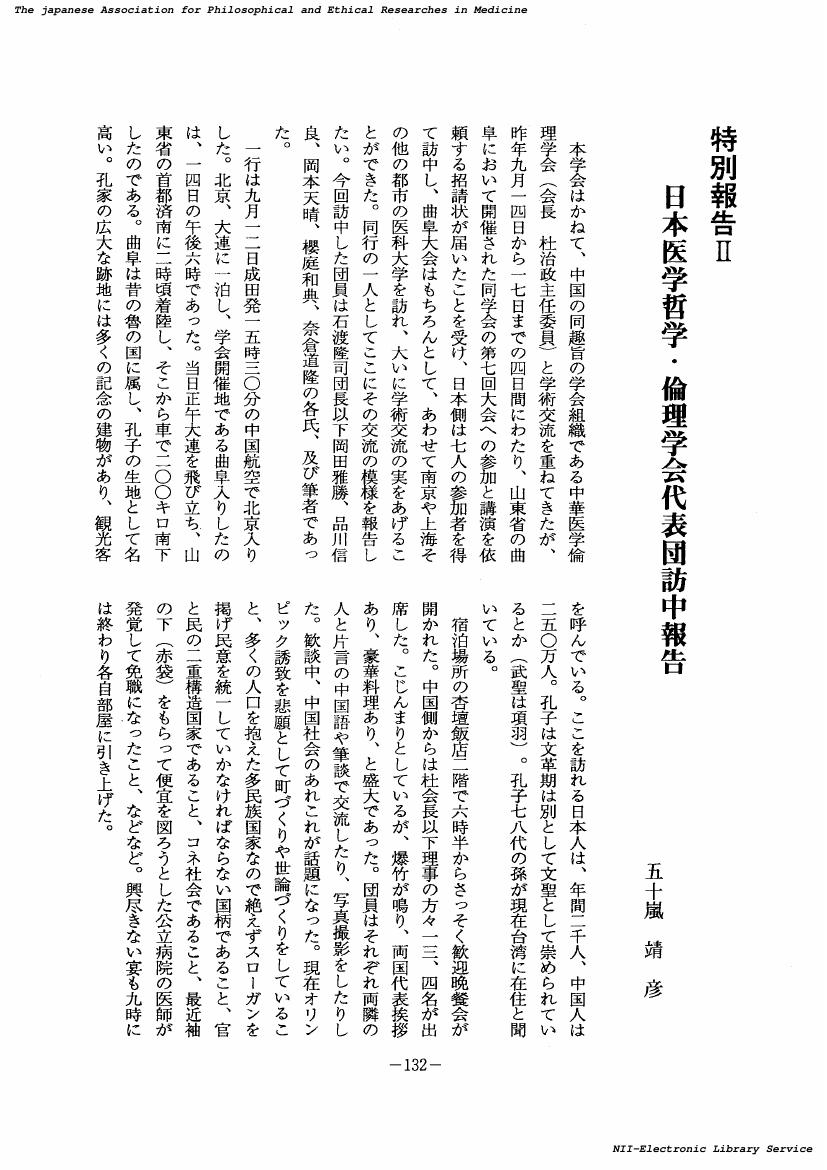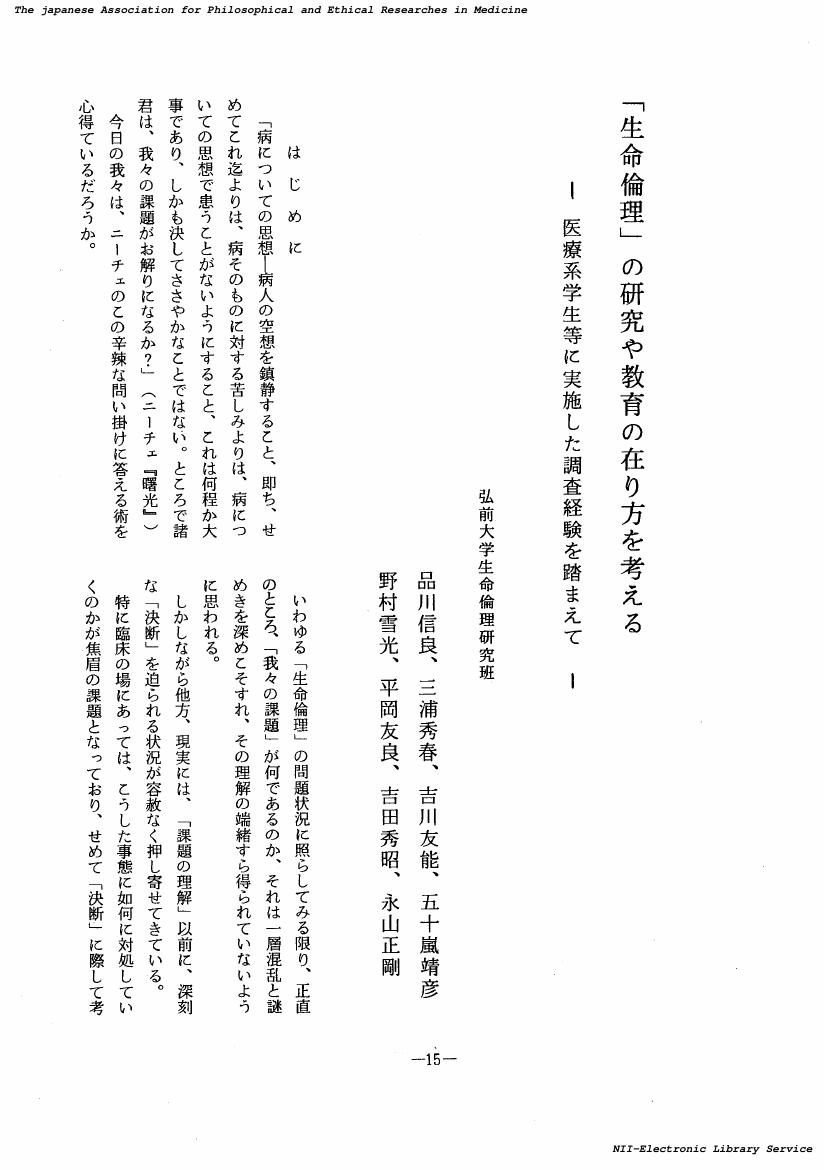1 0 0 0 IR 『マーディ』での若きメルヴィル(2)喪失と幻滅
- 著者
- 五十嵐 博
- 出版者
- 東海大学海洋学部
- 雑誌
- 海-自然と文化 = Journal of the School of Marine Science and Technology : 東海大学紀要海洋学部 (ISSN:13487620)
- 巻号頁・発行日
- vol.6, no.3, pp.39-54, 2008
本稿は, メルヴィルの第3作『マーディ』の構成, プロット, および登場人物たちを分析し, 作品に宿されている寓意的・象徴的意味を解明しようとするものである.プロットは神秘的で謎めいており, この寓意ロマンスに隠れた意味があることを暗示している.プロットの本流で発生する3つの出来事, すなわち主人公と純真無垢なイラーの出会い, イラーの失踪, そしてイラーを再発見し取り戻すための長旅が, 作品構成の言わば竜骨を形成している.失われた純潔と純真無垢の探求はマーディ中で行われるが徒労に終わり, マーディは罪悪多き現実の人間世界の縮図となっている.登場人物たちはメルヴィルの代理人もしくは分身として見て取ることができる.主人公のタジはメルヴィルの本能を, ババランジャは理性を代弁し, 復讐者たちは罪の意識を, ホーシャの使者たちは性の誘惑を意味している.イラーは純真無垢,善,理想の象徴で, ホーシャは罪の歓び, 悪, 人間の現実を象徴している.
1 0 0 0 OA 免震液体貯蔵タンクを対象としたサブストラクチャーハイブリッド振動台実験
- 著者
- 五十嵐 晃 家村 浩和 鶴田 大輝
- 出版者
- 公益社団法人 土木学会
- 雑誌
- 地震工学研究発表会 梗概集 (ISSN:18848443)
- 巻号頁・発行日
- vol.27, pp.158, 2003 (Released:2010-06-04)
1 0 0 0 単体テストを用いたチュートリアルの自動生成手法
- 著者
- 三上 裕明 坂本 大介 五十嵐 健夫
- 雑誌
- 情報処理学会論文誌プログラミング(PRO) (ISSN:18827802)
- 巻号頁・発行日
- vol.8, no.4, pp.1-14, 2015-12-04
APIの理解と使い方の学習は,プログラマにとって重要であるが,時間のかかる作業である.APIを理解するための方法の1つとして,チュートリアルがある.チュートリアルは,複数のサンプルコードおよびその説明と,それらのリストからなるドキュメントであり,ライブラリの基本的な機能の使い方を提示する.現在,チュートリアルはライブラリの開発者が記述しているが,チュートリアルを書くことは手間がかかる作業である.そのため,チュートリアルが更新されず,最新のAPIの使い方がチュートリアルで説明されていない場合がある.この問題に対処するため,本論文では,単体テストからチュートリアルを自動的に生成する手法を提案する.本手法では最初に,単体テストから実行可能なサンプルを生成する.次に,サンプルの説明を生成するために,プログラム可視化の技法を用いる.また,サンプルコードのリストを作るために,単体テスト間の依存関係を用いる.具体的には,実行時情報を用いて単体テストの依存関係を抽出し,そしてその依存関係をもとにサンプルコードを順序付けする.本手法の有効性を確認するためにユーザスタディを実施した.この結果,本手法を用いて生成されたチュートリアルを用いることで,自動生成された既存のAPIドキュメントの場合よりもAPIを効率的に理解できるという結果が得られた.
- 著者
- 五十嵐,豪
- 出版者
- 日本産科婦人科学会
- 雑誌
- 日本産科婦人科學會雜誌
- 巻号頁・発行日
- vol.62, no.2, 2010-02-01
1 0 0 0 OA 戦間期製菓業における垂直統合 ―森永製菓のグループ化の事例―
- 著者
- 五十嵐 千尋
- 出版者
- 経営史学会
- 雑誌
- 経営史学 (ISSN:03869113)
- 巻号頁・発行日
- vol.51, no.2, pp.25-50, 2016 (Released:2019-03-30)
This paper aims to provide a brief account of the growth of the Western confectionery industry in Japan, focusing on Morinaga's vertical integration during the interwar period.Western confectionary was introduced into Japan around the beginning of the Meiji period. When Morinaga was founded, in 1899, there was neither a market for the ingredients nor a distribution channel for Western confectionary in Japan. In that case, how did Morinaga procure ingredients and create a market for its new products?The dairy industry was immature in those days but had excellent business opportunities, both inside and outside the country. Morinaga thus developed these and moved into the dairy industry. Consolidating some dairy businesses into a single company after WWI, it was thereby able to steadily secure ingredients. Later, when Morinaga's performance fell, it founded a corporate spin-off as the running costs were too high for Morinaga to maintain it.In the 1920s, in order to strengthen sales when a competitor, Meiji Seika, was established, Morinaga and various wholesale stores established sales companies. There was only a low-level capital relationship between Morinaga and these sales companies, however, so their elimination or consolidation did not damage Morinaga. The sales companies to which Morinaga sold its products had to take the risk of sluggish Morinaga sales, which supported Morinaga, especially through asset liquidation and a capital reduction from 15 to 7.5 million yen. In spite of Morinaga's development of a Beltline store system, however, it was unable to control the small retail-store units.Summarizing, Morinaga took measures towards vertical integration in order to secure ingredients and control its distribution network. The immaturity of the ingredients market meant that the main factor in this aspect of the vertical integration was the stabilization of ingredients provision, while Morinaga was able to maintain its group through corporate spin-off and risk hedging.
- 著者
- 五十嵐 由香
- 出版者
- 東洋大学人間科学総合研究所
- 雑誌
- 東洋大学人間科学総合研究所紀要 (ISSN:13492276)
- 巻号頁・発行日
- no.21, pp.213-223, 2019-03
Upon release, a comedy film presenting Adolf Hitler in the leading role, Look Who's Back (Er ist wieder da, dir. David Wnendt, 2015), caused a worldwide sensation. The idea of featuring Hitler as a comic figure is immediately associated with Charles Chaplin's The Great Dictator (1940) produced during the World WarⅡ.While Hitler is the object of laughter, it appears that the comedic effect is induced more by the settings of each film. The goal of this paper is to examine the representation of Hitler in each film created in different periods in modern history and compare the ways in which they induce laughter.2015年にデヴィッド・ヴェンドが製作したドイツ映画『帰って来たヒトラー』は、タブー視されてきたヒトラーを喜劇映画の主人公にしたことにより、世界中で話題となった。この映画のワンカットにも挿入されているのだが、ヒトラーそっくりに、ドイツ語もどきの言葉を使って演説をする喜劇映画といえば、1940年のチャップリンの『独裁者』がすぐに思い浮かぶ。『独裁者』もまた、当時全盛期のヒトラーを扱った喜劇映画ということで公開前から話題となっていた。戦時と戦後という時代を隔てたこの二つの映画において、独裁者ヒトラーはどのように表象されているだろうか。本稿では、独裁者に対して起こる笑いが、映画に内在する二つの背景のコントラストから生じていることをそれぞれの映画の中に探りだし、笑いの中に見えてくる独裁者の表象を比較する。
1 0 0 0 18インチLCDバックライト用高周波電界点灯ランプ
- 著者
- 橋本 晃治 池田 完 志賀 智一 五十嵐 清 御子柴 茂生 高久 重剛 西山 清一 南村 雄一
- 出版者
- 一般社団法人電子情報通信学会
- 雑誌
- 電子情報通信学会技術研究報告. EID, 電子ディスプレイ (ISSN:09135685)
- 巻号頁・発行日
- vol.99, no.143, pp.25-30, 1999-06-24
- 参考文献数
- 4
- 被引用文献数
- 2
電界結合型放電を利用した高周波電界点灯ランプを8本用い、直下方式の18インチLCD用バックライトを開発した。高周波電界点灯ランプは、外部電極型であるため長寿命が期待でき、高周波駆動であるため高効率であると考えられる。また、外部電極の位置や数が任意であるため、より長い放電管に容易に対応できる。均一な放電を得るために、外部電極を分割して配置した。このバックライトを5.24MHz,790V_<p-p>で駆動した時、輝度3500cd/m^2,発光効率341m/Wが得られた。また、このバックライトは8本の放電管を1つのインバータで駆動できる。
1 0 0 0 海外農業事情 パラグアイ便り(3)農畜産物と食生活
- 著者
- 五十嵐 龍夫
- 出版者
- 北海道農事試驗場北農會
- 雑誌
- 北農 (ISSN:00183490)
- 巻号頁・発行日
- vol.84, no.3, pp.326-331, 2017-07
パラグアイでは自炊生活と聞いていた。イタプア県のエンカルナシオン市で,以前日本からの専門家やシニア海外ボランティア(S.V.)が間借りしていた日系人所有の家に住み,そこからカピタンミランダ市のCICM(カピタン・ミランダ研究センター)には路線バスで通勤することになった。家の台所には電気炊飯器や電子レンジがあり,自炊には不自由の無い環境である。以下,筆者の食生活に係わる農畜産物などについて報告する。筆者は自炊のために継続的に食料品を買っているが,買い物に慣れ始めた昨年の6月頃から買った物の価格を記録することにした。こちらでは小さい店では,商品に価格が付いていない場合やレシートが無い場合があるが,中規模以上のスーパーでは商品に価格表示が付き,レシートにはkg単位の価格と,買った商品の重量と価格が表示されている。それで1kg単位の価格の推移を見ることにした。尚,価格は110円=1ドル=5,500ガラニーで換算している。
1 0 0 0 OA 医療における自律原理
- 著者
- 五十嵐 靖彦
- 出版者
- 東北哲学会
- 雑誌
- 東北哲学会年報 (ISSN:09139354)
- 巻号頁・発行日
- vol.10, pp.81-83, 1994-06-30 (Released:2018-02-28)
1 0 0 0 OA 看護実践における倫理的問題解決のための概念を見出す試み : 事例分析から
- 著者
- 工藤 せい子 五十嵐 靖彦
- 出版者
- 日本医学哲学・倫理学会
- 雑誌
- 医学哲学 医学倫理 (ISSN:02896427)
- 巻号頁・発行日
- vol.24, pp.75-84, 2006-10-24 (Released:2018-02-01)
The purpose of this study was to attempt to determine general ideas for addressing ethical issues in nursing practice. The author interviewed nurses who had experienced cases involving care and related ethical issues. The interview data were analyzed using qualitative research methods. The subjects of analysis were the following three cases: 1. A client who was transferred to the hospital for reoperation but died shortly before operation; 2. A client who was in and out of the hospital for more than 10years because of incurable illness; and 3. A client whose last wish was fulfilled in the form of a Christmas party. Analysis showed that ideas for addressing ethical issues converged into two categories. The first included ethical issues, including "role as the client's advocate," "coordination between the client's wishes and the doctor's policy," and "paternalism and maternalism". The other category included issues related to caring, including "learning from the client," "formation of a strong bond resulting from mutual relationship," "involvement as a team," and "departure from medical rules". There were, in addition, three keys to addressing ethical issues that did not fit into either category: "hope for peaceful settlement of affairs," "hope for successful communication," and "wish to be treated indulgently". These three keys are useful both in care for patients and addressing ethical issues.
1 0 0 0 OA 死や臨死をめぐるオランダの実情
- 著者
- テン・ハーフ ヘンク・A・M・J 五十嵐 靖彦
- 出版者
- 日本医学哲学・倫理学会
- 雑誌
- 医学哲学 医学倫理 (ISSN:02896427)
- 巻号頁・発行日
- vol.22, pp.127-136, 2004-10-18 (Released:2018-02-01)
In the last three decades, euthanasia has been a topic of continuous debate in the Netherlands and elsewhere. I is obvious that euthanasia has medical, moral and legal aspects, but it also has cultural, social and political dimensions. In the Netherlands, after three decades of debate and practical experience, euthanasia is since April 2002 regulated as a legitimized medical intervention under particular conditions. However, the legal regulation of euthanasia does not mean that the practice has lost its controversial and contentious character. In this presentation I will focus on four issues. First, the legalization of euthanasia in the Netherlands, identifying the characteristics of the new law. Second, rules and regulations in European countries will be compared, especially the laws in Belgium and the Netherlands. It is also clear that the medical practice of euthanasia varies significantly among European countries, contrary to the implicit assumption that physicians in the Netherlands practiced openly what was hidden in other countries. Third, the issue of legalization, and the various moral and pragmatic arguments pro and con legalizing euthanasia, will be analyzed. Finally, different approaches to death and dying seem to emerge from the euthanasia debate. Three approaches are distinguished: controlled death, preventive death, and palliated death. The increasing focus on the patients' quality of life is an opportunity for the emerging approach of 'palliated death', going beyond the images of 'controlled death' and 'preventive death'.
1 0 0 0 OA 海外研修報告
- 著者
- 五十嵐 靖彦
- 出版者
- 日本医学哲学・倫理学会
- 雑誌
- 医学哲学 医学倫理 (ISSN:02896427)
- 巻号頁・発行日
- vol.15, pp.167-169, 1997-09-20 (Released:2018-02-01)
1 0 0 0 OA 第九回ヨーロッパ医学医療哲学学会大会に参加して(海外報告)
- 著者
- 五十嵐 靖彦
- 出版者
- 日本医学哲学・倫理学会
- 雑誌
- 医学哲学 医学倫理 (ISSN:02896427)
- 巻号頁・発行日
- vol.14, pp.177-179, 1996-10-01 (Released:2018-02-01)
1 0 0 0 OA インフォームド・コンセントとは何か(指定討論)(パネルディスカッション インフォームド・コンセントとは何か,<特集>病とは何か・癒しとは何か インフォームド・コンセントとは何か)
- 著者
- 五十嵐 靖彦
- 出版者
- 日本医学哲学・倫理学会
- 雑誌
- 医学哲学 医学倫理 (ISSN:02896427)
- 巻号頁・発行日
- vol.13, pp.182-187, 1995-10-01 (Released:2018-02-01)
Recently in the field of health care in Japan, as in other countries, there is increasing number of people below that every person has a right to self-decision concerning health can, so that no medical intervention may be carried out without voluntary and informed consent. This argument is, of course, valid and persuasive, at last theoretical. However once we apply this principle to each and every case of health care, we immediately confront some difficulties. Because medical case has infinite variable, and in many cases we cannot forefully obtain free and informed consent. In the first half of this paper, we consider the theoretical and historical validity of the informed consent principle. In the second half, circumstances which make it difficult to take care of patients in accordance with the concept of informed consent will be pointed out.
1 0 0 0 OA 日本医学哲学・倫理学会代表団訪中報告
- 著者
- 五十嵐 靖彦
- 出版者
- 日本医学哲学・倫理学会
- 雑誌
- 医学哲学 医学倫理 (ISSN:02896427)
- 巻号頁・発行日
- vol.12, pp.132-136, 1994-10-01 (Released:2018-02-01)
1 0 0 0 OA 「生命倫理」の研究や教育の在り方を考える : 医療系学生等に実施した調査経験を踏まえて
1 0 0 0 OA 法系論と日本法
- 著者
- 五十嵐 清
- 出版者
- 日本法哲学会
- 雑誌
- 法哲学年報 (ISSN:03872890)
- 巻号頁・発行日
- vol.1986, pp.20-36, 1987-10-20 (Released:2008-11-17)
- 参考文献数
- 37
1 0 0 0 OA 現代大陸法における法源の機能 立法と判例の関係についての一考察
- 著者
- 五十嵐 清
- 出版者
- 日本法哲学会
- 雑誌
- 法哲学年報 (ISSN:03872890)
- 巻号頁・発行日
- vol.1964, pp.47-58, 1965-04-20 (Released:2009-02-12)
- 参考文献数
- 9
1 0 0 0 OA カール・エンギッシの「法学的思考入門」
- 著者
- 五十嵐 清
- 出版者
- 日本法哲学会
- 雑誌
- 法哲学年報 (ISSN:03872890)
- 巻号頁・発行日
- vol.1958, pp.218-225, 1959-04-10 (Released:2009-02-12)
- 著者
- 高山 哲治 五十嵐 正広 大住 省三 岡 志郎 角田 文彦 久保 宜明 熊谷 秀規 佐々木 美香 菅井 有 菅野 康吉 武田 祐子 土山 寿志 阪埜 浩司 深堀 優 古川 洋一 堀松 高博 六車 直樹 石川 秀樹 岩間 毅夫 岡﨑 康司 斎藤 豊 松浦 成昭 武藤 倫弘 冨田 尚裕 秋山 卓士 山本 敏樹 石田 秀行 中山 佳子
- 出版者
- 一般社団法人 日本遺伝性腫瘍学会
- 雑誌
- 遺伝性腫瘍 (ISSN:24356808)
- 巻号頁・発行日
- vol.20, no.2, pp.93-114, 2020 (Released:2020-09-25)
- 参考文献数
- 62
Cowden症候群/PTEN過誤腫症候群は,PTEN遺伝子の生殖細胞系列の病的バリアントを原因とする常染色体優性遺伝性の希少疾患である.消化管,皮膚,粘膜,乳房,甲状腺,子宮内膜,脳などに過誤腫性病変の多発を特徴とする.巨頭症および20歳代後半までに多発性皮膚粘膜病変を発症することが多い.ときに小児期に多発する消化管病変,自閉スペクトラム症,知的障害が診断の契機となる.また,がん遺伝子パネル検査によって診断される可能性がある.乳癌,甲状腺癌,子宮内膜癌,大腸癌,腎細胞癌などの悪性腫瘍を合併するリスクが高く,適切なサーベイランスが必要である. 本診療ガイドラインでは,小児から成人にかけてシームレスに,正確な診断と適切な治療・サーベイランスが行われるよう,基本的事項を解説し,4個のクリニカルクエスチョンと推奨を作成した.








